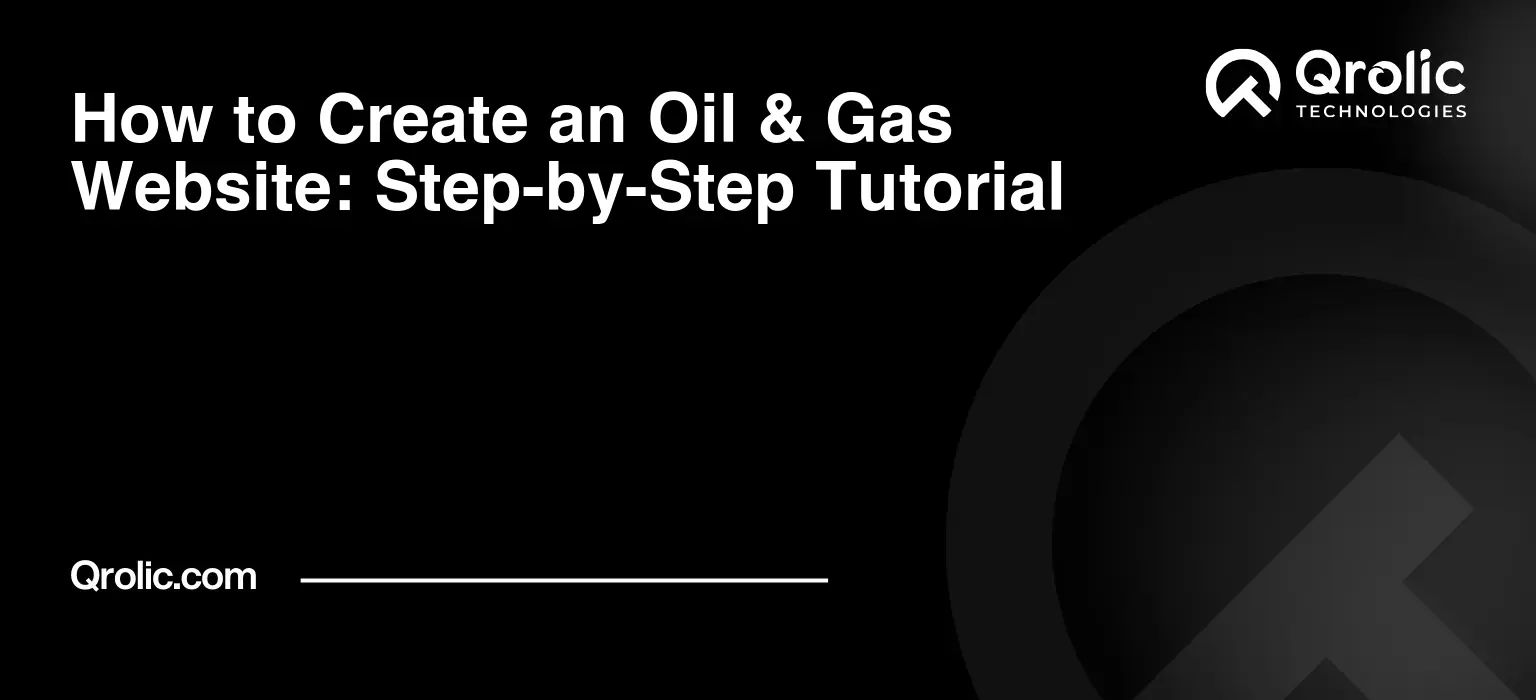Quick Summary:
- Define your website’s purpose and target audience first.
- Build with a CMS like WordPress and a professional theme.
- Optimize for SEO and promote through digital marketing.
- Regularly test, maintain, and analyze website performance.
Table of Contents
- Section 1: Laying the Foundation: Why Your Oil & Gas Business Needs a Website
- 1.1. The Digital Oilfield: Why Online Presence is No Longer Optional
- 1.2. Defining Your Website’s Purpose: What Do You Want to Achieve?
- 1.3. Understanding Your Target Audience: Who Are You Trying to Reach?
- Section 2: Planning & Structuring Your Oil & Gas Website
- 2.1. Domain Name & Hosting: Choosing the Right Foundation
- 2.2. Sitemap & Navigation: Guiding Visitors Through Your Website
- 2.3. Content Planning: What Information Will You Share?
- Section 3: Building Your Oil & Gas Website: Step-by-Step
- 3.1. Choosing a Website Platform: CMS vs. Custom Development
- 3.2. Selecting a Theme or Template: Design for the Energy Industry
- 3.3. Essential Plugins & Functionality: Extending Your Website’s Capabilities
- 3.4. Populating Your Website with Content: Creating Engaging and Informative Pages
- Section 4: Optimizing Your Website for Search Engines (SEO)
- 4.1. Keyword Research: Finding the Right Terms to Target
- 4.2. On-Page Optimization: Making Your Website Search Engine Friendly
- 4.3. Off-Page Optimization: Building Authority and Credibility
- 4.4. Technical SEO: Ensuring Your Website is Crawlable and Indexable
- Section 5: Testing, Launching, and Maintaining Your Oil & Gas Website
- 5.1. Thorough Testing: Ensuring a Flawless User Experience
- 5.2. Launching Your Website: Making it Live to the World
- 5.3. Ongoing Maintenance: Keeping Your Website Fresh and Secure
- Section 6: Promoting Your Oil & Gas Website
- 6.1. Search Engine Marketing (SEM): Paid Advertising for Instant Visibility
- 6.2. Social Media Marketing (SMM): Building Relationships and Driving Traffic
- 6.3. Email Marketing: Nurturing Leads and Building Customer Loyalty
- 6.4. Content Marketing: Providing Value and Establishing Authority
- Section 7: Qrolic Technologies: Your Partner in Digital Transformation
- Section 8: Measuring Success: Analyzing Your Website’s Performance
- 8.1. Key Performance Indicators (KPIs): Tracking What Matters
- 8.2. Tools for Website Analytics: Gathering Data and Insights
- 8.3. Analyzing Data and Making Improvements: Continuous Optimization
Section 1: Laying the Foundation: Why Your Oil & Gas Business Needs a Website

1.1. The Digital Oilfield: Why Online Presence is No Longer Optional
In today’s interconnected world, the oil and gas industry, like every other sector, operates in a digital landscape. A website isn’t just a fancy online brochure; it’s the digital storefront, the 24/7 networking hub, and the credibility anchor for your business. Think of it this way: potential clients, investors, and even future employees are Googling you right now. What will they find?
- Visibility & Lead Generation: The internet is the new Yellow Pages. People search online for solutions, and if you don’t have a website, you’re essentially invisible. An optimized website attracts potential clients actively searching for oil and gas services or products.
- Credibility & Trust: A professional website builds trust. It shows you’re serious about your business and willing to invest in your online presence. Think of it as the digital equivalent of a well-maintained office building.
- Communication & Information Hub: A website serves as a central information source, providing details about your services, projects, team, and company history. It’s a place to answer frequently asked questions and keep your audience informed.
- Competitive Advantage: Many smaller oil and gas companies still lack a strong online presence. Having a well-designed website gives you a competitive edge, allowing you to stand out and capture market share.
- Cost-Effective Marketing: Compared to traditional advertising methods, a website is a cost-effective marketing tool. It works for you around the clock, reaching a wider audience at a fraction of the cost.
1.2. Defining Your Website’s Purpose: What Do You Want to Achieve?
Before diving into design and development, clarity is key. What is the primary goal of your oil and gas website? Defining your objectives will shape your website’s content, structure, and overall strategy.
- Lead Generation: Is your main goal to generate leads for your services? If so, focus on compelling calls-to-action (CTAs), contact forms, and lead magnets (e.g., free guides, webinars).
- Brand Building: Do you want to establish your company as a thought leader in the energy industry? Focus on content marketing, publishing insightful articles, white papers, and industry reports.
- Recruitment: Are you looking to attract top talent? Showcase your company culture, employee benefits, and career opportunities.
- Investor Relations: Do you need to provide information to investors? Create a dedicated investor relations section with financial reports, presentations, and contact information.
- E-commerce (Product Sales): Do you sell oil and gas equipment or products online? Integrate an e-commerce platform to facilitate online transactions.
Knowing your why will guide every decision you make in the website creation process.
1.3. Understanding Your Target Audience: Who Are You Trying to Reach?
Identifying your target audience is crucial for creating a website that resonates with them. Consider their needs, pain points, and what information they’re seeking.
- Potential Clients (Operators, Investors): What challenges are they facing? What solutions can you offer? What information do they need to make a decision?
- Potential Employees: What are they looking for in an employer? What skills and experience do they have? What motivates them?
- Investors: What financial information are they interested in? What is your company’s growth strategy?
- Partners & Suppliers: How can you streamline communication and collaboration? What information do they need to work with you effectively?
Tailor your website’s content, design, and messaging to appeal to your specific target audience. Understand their digital literacy levels and the types of devices they use to access the internet (desktop, mobile, tablet).
Section 2: Planning & Structuring Your Oil & Gas Website

2.1. Domain Name & Hosting: Choosing the Right Foundation
Your domain name is your website’s address on the internet. Choose a name that is memorable, relevant, and easy to spell.
- Relevance: Ideally, your domain name should include keywords related to your business or industry (e.g., “OilfieldServices.com,” “EnergySolutions.net”).
- Memorability: Keep it short, simple, and easy to remember. Avoid hyphens or unusual spellings.
- Availability: Check if the domain name is available and register it through a reputable domain registrar (e.g., GoDaddy, Namecheap).
- .com vs. Other Extensions: While .com is the most common and recognizable extension, consider other options like .net, .org, or industry-specific extensions if your desired .com is unavailable.
Web Hosting:
Web hosting is where your website files are stored, making them accessible to visitors. Choose a hosting provider that offers reliable performance, security, and scalability.
- Shared Hosting: The most affordable option, where your website shares server resources with other websites. Suitable for smaller websites with limited traffic.
- VPS Hosting (Virtual Private Server): Provides more resources and control than shared hosting. Suitable for growing businesses with moderate traffic.
- Dedicated Hosting: You have your own dedicated server, offering maximum performance and control. Suitable for large enterprises with high traffic and demanding requirements.
- Cloud Hosting: A flexible and scalable option that uses a network of servers to host your website. Offers high availability and redundancy.
Consider factors like uptime guarantees, server location (choose a location close to your target audience), customer support, and security features when selecting a hosting provider.
2.2. Sitemap & Navigation: Guiding Visitors Through Your Website
A well-structured sitemap is essential for both user experience and SEO. It helps visitors find the information they need quickly and easily, and it helps search engines crawl and index your website effectively.
- Plan Your Website Structure: Create a logical hierarchy of pages, starting with the homepage and branching out to subpages.
- Prioritize Key Pages: Place the most important pages (e.g., services, about us, contact) in the main navigation menu.
- Use Clear and Concise Labels: Use descriptive labels for your navigation menu items that accurately reflect the content of each page.
- Implement a User-Friendly Navigation Menu: Use a clear and intuitive navigation menu that is easy to find and use on both desktop and mobile devices.
- Create a Footer Navigation: Include a footer navigation menu with links to important pages, such as your privacy policy, terms of service, and contact information.
- Sitemap Page: Create a dedicated sitemap page that lists all the pages on your website. This can be helpful for both users and search engines.
Example Sitemap Structure:
- Homepage
- About Us
- Our Mission
- Our Team
- Our History
- Services
- Drilling Services
- Production Services
- Engineering Services
- Consulting Services
- Projects
- Project 1
- Project 2
- Project 3
- Careers
- Open Positions
- Benefits
- Apply Now
- News & Insights
- Blog
- Industry News
- White Papers
- Contact Us
2.3. Content Planning: What Information Will You Share?
Content is king. Your website’s content should be informative, engaging, and optimized for search engines.
- Homepage Content: A compelling overview of your company, its mission, and its services. Highlight your key value propositions and include a clear call-to-action.
- About Us Page: Tell your company’s story. Highlight your history, values, team, and accomplishments. Build trust and credibility.
- Services Pages: Describe your services in detail, highlighting their benefits and how they solve your clients’ problems. Use case studies and testimonials to demonstrate your expertise.
- Projects Page: Showcase your past projects and accomplishments. Include details about the scope of work, challenges overcome, and results achieved.
- Careers Page: Attract top talent by showcasing your company culture, employee benefits, and career opportunities. Make it easy for candidates to apply.
- News & Insights (Blog): Publish regular blog posts, articles, and industry news to establish your company as a thought leader and improve your SEO.
- Contact Us Page: Make it easy for visitors to contact you. Include a contact form, phone number, email address, and physical address (if applicable).
Content Optimization Tips:
- Keyword Research: Identify relevant keywords that your target audience is searching for.
- Use Headings & Subheadings: Break up your content with headings and subheadings to improve readability and SEO.
- Write Clear and Concise Content: Use simple language and avoid jargon.
- Optimize Images: Use descriptive alt tags for your images to improve SEO.
- Proofread Carefully: Ensure your content is free of errors.
Section 3: Building Your Oil & Gas Website: Step-by-Step

3.1. Choosing a Website Platform: CMS vs. Custom Development
You have two main options for building your website: using a Content Management System (CMS) or opting for custom development.
- Content Management System (CMS): A user-friendly platform that allows you to create and manage your website content without coding knowledge. Popular CMS options include wordpress, Joomla, and Drupal.
- Pros: Easy to use, cost-effective, readily available themes and plugins, large community support.
- Cons: Can be less flexible than custom development, potential security vulnerabilities if not properly maintained.
- Custom Development: Building your website from scratch using programming languages like HTML, CSS, JavaScript, and PHP.
- Pros: Highly customizable, allows for unique design and functionality, greater control over security.
- Cons: More expensive, requires technical expertise, longer development time.
For most oil and gas businesses, a CMS like WordPress is the best option due to its ease of use, flexibility, and cost-effectiveness.
3.2. Selecting a Theme or Template: Design for the Energy Industry
Your website’s design should be professional, modern, and reflect the energy industry.
- Premium Themes: Purchase a premium theme from a reputable theme marketplace (e.g., ThemeForest, Elegant Themes). These themes typically offer more features, customization options, and support than free themes.
- Industry-Specific Themes: Look for themes specifically designed for the oil and gas or energy industry. These themes often include relevant features and design elements.
- Clean and Professional Design: Choose a theme with a clean, professional design that is easy to navigate and visually appealing.
- Mobile Responsiveness: Ensure the theme is mobile-responsive, meaning it adapts to different screen sizes and devices.
- Customization Options: Look for a theme that offers a range of customization options, allowing you to tailor the design to your brand.
Design Considerations for the Oil & Gas Industry:
- Color Palette: Use a professional color palette that reflects the energy industry (e.g., blues, greens, grays).
- Imagery: Use high-quality images and videos of oil and gas operations, equipment, and projects.
- Typography: Choose clear and readable fonts.
- Whitespace: Use whitespace effectively to create a clean and uncluttered design.
3.3. Essential Plugins & Functionality: Extending Your Website’s Capabilities
Plugins are extensions that add functionality to your website. Here are some essential plugins for oil and gas websites:
- SEO Plugin (e.g., Yoast SEO, Rank Math): Helps you optimize your website for search engines.
- Contact Form Plugin (e.g., Contact Form 7, Gravity Forms): Allows visitors to contact you easily.
- Security Plugin (e.g., Wordfence, Sucuri): Protects your website from malware and hackers.
- Caching Plugin (e.g., WP Rocket, W3 Total Cache): Improves Website Speed and performance.
- Analytics Plugin (e.g., Google Analytics): Tracks website traffic and user behavior.
- Image Optimization Plugin (e.g., Smush, Imagify): Optimizes images for faster loading times.
- Social Media Sharing Plugin (e.g., Social Warfare, AddToAny): Allows visitors to easily share your content on social media.
Specific Functionality for Oil & Gas Websites:
- Interactive Maps: Display your project locations on an interactive map.
- Project Portfolio: Showcase your past projects with detailed descriptions and images.
- Equipment Catalog: Display your equipment for sale or rent with specifications and pricing.
- Document Library: Provide access to technical documents, brochures, and reports.
3.4. Populating Your Website with Content: Creating Engaging and Informative Pages
Now it’s time to add your content to your website. Follow these tips to create engaging and informative pages:
- Write for Your Audience: Use language that your target audience understands. Avoid jargon and technical terms unless necessary.
- Focus on Benefits: Highlight the benefits of your services and products. Explain how they solve your clients’ problems.
- Use Visuals: Include images, videos, and infographics to break up your text and make your content more engaging.
- Call to Action (CTA): Include clear calls to action on every page. Tell visitors what you want them to do (e.g., “Contact Us,” “Request a Quote,” “Download Our Brochure”).
- Proofread Carefully: Ensure your content is free of errors before publishing.
Example Content Snippets:
- Service Page (Drilling Services): “Our drilling services provide safe, efficient, and cost-effective solutions for your oil and gas exploration and production needs. We utilize state-of-the-art technology and experienced personnel to deliver exceptional results, on time and on budget.”
- About Us Page: “With over 20 years of experience in the oil and gas industry, [Company Name] has established a reputation for excellence in providing innovative and reliable solutions. Our team of highly skilled engineers, technicians, and project managers is committed to delivering exceptional value to our clients.”
- Project Page: “[Project Name] involved the drilling of five wells in the [Location] field. Our team successfully completed the project ahead of schedule and under budget, exceeding our client’s expectations. We utilized advanced drilling techniques to minimize environmental impact and maximize production.”
Section 4: Optimizing Your Website for Search Engines (SEO)
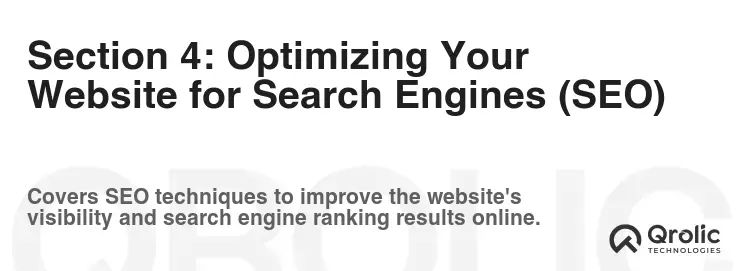
4.1. Keyword Research: Finding the Right Terms to Target
Keyword research is the foundation of any successful SEO strategy. Identify the keywords that your target audience is using to search for oil and gas services and products.
- Brainstorming: Start by brainstorming a list of keywords related to your business.
- Keyword Research Tools: Use keyword research tools like Google Keyword Planner, Ahrefs, SEMrush, and Moz Keyword Explorer to identify high-volume, low-competition keywords.
- Competitor Analysis: Analyze your competitors’ websites to see what keywords they are targeting.
- Long-Tail Keywords: Focus on long-tail keywords (longer, more specific phrases) to attract a more targeted audience.
Example Keywords for Oil & Gas Websites:
- “oil and gas drilling services”
- “oilfield equipment supplier”
- “energy industry consulting”
- “pipeline construction company”
- “oil and gas engineering services”
- “offshore drilling rigs”
- “fracking services”
- “oil and gas recruitment”
- “petroleum engineering jobs”
4.2. On-Page Optimization: Making Your Website Search Engine Friendly
On-page optimization involves optimizing your website’s content and structure to improve its ranking in search results.
- Title Tags: Optimize your title tags with relevant keywords. Keep them under 60 characters.
- Meta Descriptions: Write compelling meta descriptions that entice users to click on your website in search results. Keep them under 160 characters.
- Header Tags (H1-H6): Use header tags to structure your content and highlight important keywords.
- URL Structure: Use short, descriptive URLs that include relevant keywords.
- Image Alt Tags: Use descriptive alt tags for your images that include relevant keywords.
- Internal Linking: Link to other relevant pages on your website to improve user experience and SEO.
- Keyword Density: Use keywords naturally throughout your content. Avoid keyword stuffing.
- Content Length: Aim for longer, more comprehensive content (at least 1000 words per page).
4.3. Off-Page Optimization: Building Authority and Credibility
Off-page optimization involves building your website’s authority and credibility through external factors.
- Link Building: Acquire backlinks from other reputable websites in the oil and gas industry.
- Social Media Marketing: Promote your website and content on social media.
- Directory Listings: List your website in relevant online directories.
- Guest Blogging: Write guest posts for other websites in the oil and gas industry.
- Online Reputation Management: Monitor your online reputation and address any negative reviews or comments.
4.4. Technical SEO: Ensuring Your Website is Crawlable and Indexable
Technical SEO involves optimizing the technical aspects of your website to ensure it is easily crawlable and indexable by search engines.
- Website Speed: Optimize your website for speed. Use a caching plugin, optimize images, and choose a fast hosting provider.
- Mobile Friendliness: Ensure your website is mobile-friendly.
- Sitemap: Submit your sitemap to search engines.
- Robots.txt: Create a robots.txt file to tell search engines which pages to crawl and which to ignore.
- SSL Certificate: Install an SSL certificate to secure your website.
- Structured Data Markup: Use structured data markup to provide search engines with more information about your content.
Section 5: Testing, Launching, and Maintaining Your Oil & Gas Website
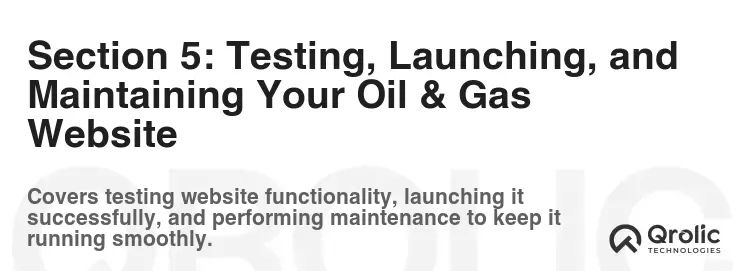
5.1. Thorough Testing: Ensuring a Flawless User Experience
Before launching your website, it’s crucial to thoroughly test it to ensure a flawless user experience.
- Functionality Testing: Test all forms, links, and buttons to ensure they are working correctly.
- Compatibility Testing: Test your website on different browsers and devices.
- Mobile Testing: Test your website on different mobile devices and screen sizes.
- Performance Testing: Test your website’s speed and performance.
- Usability Testing: Ask friends, family, or colleagues to test your website and provide feedback.
- Security Testing: Conduct a security audit to identify and fix any vulnerabilities.
5.2. Launching Your Website: Making it Live to the World
Once you’ve thoroughly tested your website, it’s time to launch it to the world.
- Backup Your Website: Create a backup of your website before launching it.
- Change DNS Settings: Update your domain name’s DNS settings to point to your hosting server.
- Submit to Search Engines: Submit your website to search engines like Google and Bing.
- Monitor Website Traffic: Monitor your website traffic using Google Analytics to track your progress.
5.3. Ongoing Maintenance: Keeping Your Website Fresh and Secure
Website maintenance is an ongoing process. Keep your website fresh, secure, and up-to-date to ensure a positive user experience and maintain your SEO ranking.
- Regularly Update Your CMS and Plugins: Keep your CMS and plugins updated to the latest versions to ensure security and compatibility.
- Backup Your Website Regularly: Back up your website regularly to protect against data loss.
- Monitor Website Security: Monitor your website for security threats and vulnerabilities.
- Update Your Content Regularly: Keep your content fresh and relevant by adding new blog posts, articles, and case studies.
- Analyze Website Traffic and User Behavior: Analyze your website traffic and user behavior to identify areas for improvement.
- Respond to User Feedback: Respond to user feedback and address any issues or concerns.
Section 6: Promoting Your Oil & Gas Website
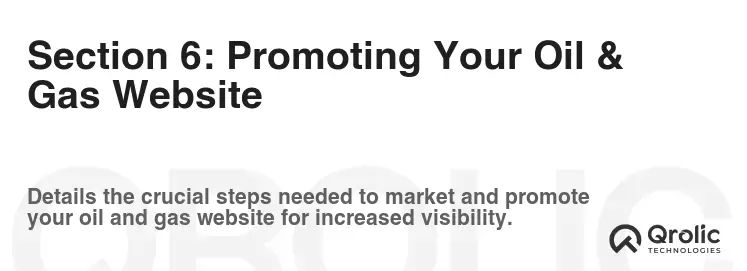
6.1. Search Engine Marketing (SEM): Paid Advertising for Instant Visibility
SEM, or paid advertising, provides immediate visibility in search engine results pages (SERPs). Google Ads is the dominant platform, offering various campaign types to target specific keywords and demographics.
- Keyword Selection: Use the keyword research conducted for SEO to identify relevant and high-converting keywords for your SEM campaigns.
- Ad Copy Creation: Craft compelling ad copy that highlights your unique selling points and includes a clear call to action.
- Landing Page Optimization: Ensure that your ad landing pages are relevant to the ad copy and offer a seamless user experience.
- Bidding Strategy: Choose a bidding strategy that aligns with your budget and goals, such as cost-per-click (CPC) or cost-per-acquisition (CPA).
- Campaign Monitoring and Optimization: Regularly monitor your SEM campaigns and make adjustments to improve performance, such as optimizing keywords, ad copy, and landing pages.
6.2. Social Media Marketing (SMM): Building Relationships and Driving Traffic
Social media marketing helps build brand awareness, engage with your target audience, and drive traffic to your website. Platforms like LinkedIn are particularly relevant for the oil and gas industry.
- Platform Selection: Choose the social media platforms that are most relevant to your target audience. For the oil and gas industry, LinkedIn is often the most effective platform.
- Content Strategy: Develop a content strategy that provides valuable and engaging content to your audience, such as industry news, blog posts, case studies, and videos.
- Community Engagement: Engage with your audience by responding to comments, answering questions, and participating in industry discussions.
- Paid Social Advertising: Use paid social advertising to reach a wider audience and target specific demographics.
- Social Media Analytics: Track your social media performance using analytics tools to measure your reach, engagement, and website traffic.
6.3. Email Marketing: Nurturing Leads and Building Customer Loyalty
Email marketing is a cost-effective way to nurture leads, build customer loyalty, and drive traffic to your website.
- Building an Email List: Collect email addresses from website visitors, trade shows, and other sources.
- Segmentation: Segment your email list based on demographics, interests, and behavior.
- Email Content Creation: Create engaging and informative email content that provides value to your subscribers.
- Automation: Use email automation tools to send automated emails based on specific triggers, such as subscribing to your email list or downloading a lead magnet.
- Email Analytics: Track your email marketing performance using analytics tools to measure your open rates, click-through rates, and conversion rates.
6.4. Content Marketing: Providing Value and Establishing Authority
Content marketing involves creating and distributing valuable, relevant, and consistent content to attract and engage a target audience.
- Blog Posts: Publish regular blog posts on topics that are relevant to your target audience.
- Case Studies: Showcase your past projects and accomplishments with detailed case studies.
- White Papers: Provide in-depth information on industry trends and challenges with white papers.
- Infographics: Create visually appealing infographics to present complex information in an easy-to-understand format.
- Videos: Produce videos that showcase your expertise, company culture, and products or services.
Section 7: Qrolic Technologies: Your Partner in Digital Transformation
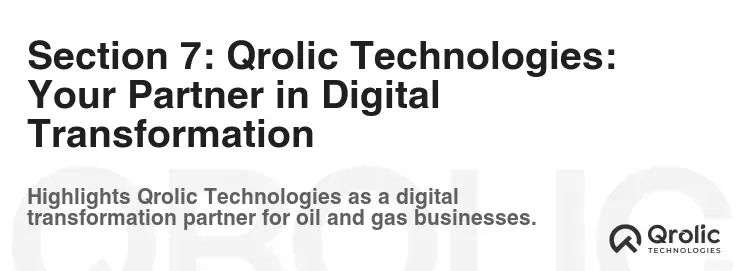
In the dynamic landscape of the oil and gas industry, a strong digital presence is no longer a luxury but a necessity. Qrolic Technologies (https://qrolic.com/) understands the unique challenges and opportunities that oil and gas companies face in the digital realm.
Why Choose Qrolic Technologies?
- Industry Expertise: Qrolic Technologies possesses a deep understanding of the oil and gas industry, allowing us to create tailored solutions that address your specific needs.
- Comprehensive Services: From website design and development to SEO, SEM, and social media marketing, Qrolic Technologies offers a full suite of digital marketing services.
- Data-Driven Approach: Qrolic Technologies leverages data analytics to track performance, identify areas for improvement, and optimize your digital marketing campaigns for maximum ROI.
- Customized Solutions: Qrolic Technologies understands that every oil and gas company is unique. We work closely with you to develop customized solutions that align with your business goals and objectives.
- Proven Results: Qrolic Technologies has a proven track record of helping oil and gas companies improve their online presence, generate leads, and drive business growth.
How Qrolic Technologies Can Help You:
- Website Design & Development: Create a professional and user-friendly website that showcases your expertise and attracts potential clients.
- SEO Optimization: Improve your website’s ranking in search results and attract more organic traffic.
- SEM Campaigns: Generate leads and drive traffic to your website with targeted SEM campaigns.
- Social Media Marketing: Build brand awareness, engage with your target audience, and drive traffic to your website with social media marketing.
- Content Marketing: Create valuable and engaging content that establishes your company as a thought leader in the oil and gas industry.
Partner with Qrolic Technologies and take your oil and gas business to the next level. Contact us today to learn more about our services and how we can help you achieve your digital marketing goals. Visit https://qrolic.com/ to explore our offerings and connect with our team.
Section 8: Measuring Success: Analyzing Your Website’s Performance
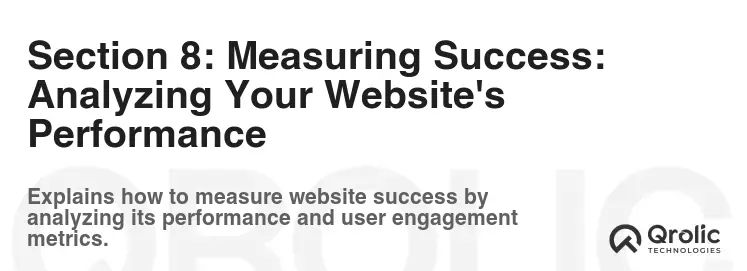
8.1. Key Performance Indicators (KPIs): Tracking What Matters
To effectively gauge the success of your oil and gas website, it’s essential to identify and track relevant Key Performance Indicators (KPIs). These metrics provide insights into your website’s performance and help you make informed decisions to optimize your online presence.
- Website Traffic: Measures the total number of visits to your website. An increase in website traffic indicates greater visibility and reach.
- Bounce Rate: Represents the percentage of visitors who leave your website after viewing only one page. A high bounce rate may indicate issues with website content, design, or user experience.
- Average Session Duration: Measures the average amount of time visitors spend on your website during a single session. A longer session duration suggests that visitors are engaged with your content.
- Conversion Rate: Represents the percentage of visitors who complete a desired action, such as filling out a contact form or requesting a quote. A higher conversion rate indicates greater effectiveness in lead generation.
- Lead Generation: Tracks the number of leads generated through your website. This metric is crucial for assessing the effectiveness of your website in attracting potential clients.
- Cost Per Lead (CPL): Measures the cost of acquiring a single lead through your website. A lower CPL indicates greater efficiency in lead generation.
- Return on Investment (ROI): Calculates the profitability of your website by comparing the revenue generated to the investment made in website development and marketing.
8.2. Tools for Website Analytics: Gathering Data and Insights
Various tools are available to collect and analyze data about your website’s performance. These tools provide valuable insights into user behavior, traffic sources, and conversion rates.
- Google Analytics: A free and widely used web analytics service that provides detailed information about website traffic, user behavior, and conversion rates.
- Google Search Console: A free tool that helps you monitor your website’s performance in Google search results. It provides insights into search queries, indexing status, and mobile usability.
- SEMrush: A comprehensive SEO and competitive analysis tool that helps you track your website’s ranking, analyze your competitors, and identify keyword opportunities.
- Ahrefs: Another popular SEO tool that provides data on backlinks, keyword research, and competitor analysis.
- Crazy Egg: A heat mapping tool that visualizes user behavior on your website. It shows where visitors click, scroll, and focus their attention.
8.3. Analyzing Data and Making Improvements: Continuous Optimization
The data collected from website analytics tools is only valuable if it is analyzed and used to make improvements to your website. Regularly review your KPIs and identify areas where your website is underperforming.
- Identify Weaknesses: Analyze your website’s data to identify areas where improvements are needed. For example, a high bounce rate on a particular page may indicate issues with the content or design.
- Implement Changes: Make changes to your website based on the data you have collected. For example, you may need to rewrite content, improve the design, or add a clear call to action.
- Monitor Results: Monitor the results of your changes to see if they have improved your website’s performance.
- Repeat the Process: Continuously analyze your website’s data and make improvements to optimize your online presence.
